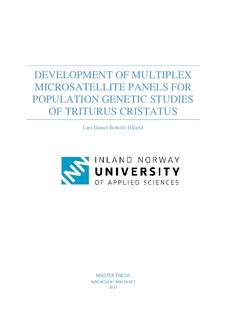DEVELOPMENT OF MULTIPLEX MICROSATELLITE PANELS FOR POPULATION GENETIC STUDIES OF TRITURUS CRISTATUS
Abstract
A genotype method for nothern crested newt (Triturus cristatus) was developed at Inland Norway University of Applied Sciences, Campus Hamar, by using already validated microsatellite markers. The population of amphibians is known to decline in rapid speed. Development of polymorphic microsatellite markers have the potential to estimate genetic variation in northern crested newt populations and investigate the effect of human intrusive, which causes changes to their habitat.
The program MPprimer designed primers from already validated microsatellite markers and the primers were amplified by a PCR reaction followed by agarose gel. Successfully amplified primers were employed to develop a multiplex PCR with the help of the program Multiplex Manager 1.2. Two different multiplexes with seven and four primer sets were developed with the help of Applied Biosystems 3130xl Genetic Analyzer accompanied by GeneMapper (v 5.0).
DNA from 131 individuals were isolated in 4 different populations from the county Buskerud and Hedmark in Norway. Out of the 11 microsatellite markers, 8 were observed to be polymorphic loci and 3 were monomorphic loci with a mean of number of alleles per loci of 5.2. Two of the markers, AJ292517 and KF442197 had high margin of error and no peaks were observed in the genotyping on the population of Bjørsrud. Overall, over the 4 different population genotyped, the microsatellite markers observed peaks 73% of the time. The population study showed genetic similarities between the populations Bjørsrud and Solheim, while Vivestad and Lahell were more isolated.
Description
Master of applied and commercial biotechnology.
